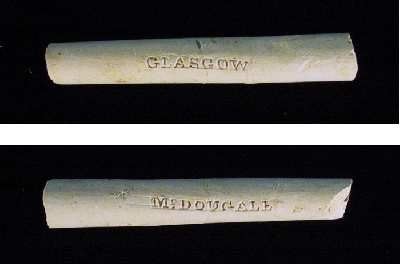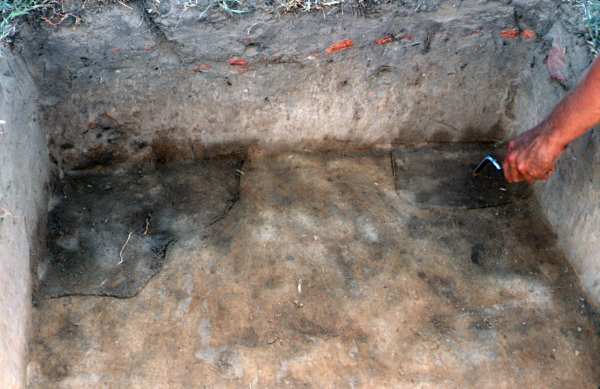August 9, 2002
Excitement has increased the last two days as our larger test units progress. On the whole the work is meeting expectations. Very dry conditions have been our greatest challenge as they make the soil extremely hard to move. The crew has resorted to using mattocks for what otherwise is delicate work.
 Four 1 x 1-meter test units were laid out on Tuesday this week in areas where shovel tests showed interesting potential. Excavation of the units started late Wednesday morning and by the end of the day Thursday two were completed. In the meantime, two others were started and should be finished by the end of today.
Four 1 x 1-meter test units were laid out on Tuesday this week in areas where shovel tests showed interesting potential. Excavation of the units started late Wednesday morning and by the end of the day Thursday two were completed. In the meantime, two others were started and should be finished by the end of today.
Guided by the preliminary shovel test findings, the test units are excavated according to natural levels or "strata". Three major strata occur on the site. The uppermost is a grayish brown "topsoil" or A-horizon almost one foot thick. It contains a great variety of artifacts, ranging from ancient Indian debris to rubbish from the 1800s to pocket change lost in the last few years. This upper soil is relatively churned up by garden plowing and modern yard activity, not to mention demolition of dilapidated houses that were once on the lot.
 Below the topsoil is a thinner, lighter colored soil that is largely undisturbed. Artifacts at this level tend to be the oldest from the site. Mixed with Indian artifacts are pieces of colonial-period ceramic, glass, and smoking pipe. It is at the level of this lighter colored soil that we can begin to see intact "features", those stains indicative of pits, postholes, cellars, and the like that were mentioned in the last progress report.
Below the topsoil is a thinner, lighter colored soil that is largely undisturbed. Artifacts at this level tend to be the oldest from the site. Mixed with Indian artifacts are pieces of colonial-period ceramic, glass, and smoking pipe. It is at the level of this lighter colored soil that we can begin to see intact "features", those stains indicative of pits, postholes, cellars, and the like that were mentioned in the last progress report.
At the top of the next stratum our excavation stops. This deepest soil, 18–24 inches below the surface, is what we refer to as “subsoil.” It is a yellowish red, stiff deposit that is very old, having been laid down by an ancient sea that once extended as far inland as Richmond and Petersburg. There are no artifacts (items made or used by people) in this soil other than those that may occur in features that intrude into it. In other words, former occupants of the site occasionally dug deeper holes that penetrated all three strata, and these were later filled in with mixed soil and artifacts to create features (things we archaeologists really get excited by!).
As we excavate these larger units the quantity and range of artifacts naturally increases. Things we are seeing as all the soil from test units is sifted tell a story many millennia long. The oldest artifacts are among the most common – pieces of debris left by Indians several thousand years ago as they made stone tools like spear points and knives. Later Indian artifacts are turning up, too, like small fragments of pottery bowls used for cooking food. The style of the pottery tells us that an Indian community resided in this part of City Point when English explorers first arrived and met the Appomatuck Indians in 1607. Maybe some of these belonged to the famous "Queen of the Appomatuck".
Colonial artifacts are not abundant in our excavations so far. But we have found some pottery, pipes, and bottle glass that dates from the 1700s. The relative scarcity of this material might be due to the fact the project area was at the edge of the most active area of the old Eppes plantation. Our historical documents research is continuing to help us understand this relationship. Some of the artifacts from this period could also come from the tavern that was on the adjacent lot across Bank Street.
 Far and away the greater portion of artifacts from all units dates to the period 1800 – 1925. This reflects the time of intensive activity on the property connected to establishment of City Point village in the 1830s, the Civil War, and then development of 20th-century Hopewell. As noted in the last report, records indicate the first house on the property was erected about 1840.
Far and away the greater portion of artifacts from all units dates to the period 1800 – 1925. This reflects the time of intensive activity on the property connected to establishment of City Point village in the 1830s, the Civil War, and then development of 20th-century Hopewell. As noted in the last report, records indicate the first house on the property was erected about 1840.
At this point, the first two test units are providing signs of good things to come. At the end of the day yesterday, two features were identified in the bottom of one of them. The units do not fully expose the features but our best guess is they mark the location of posts set into the ground for buildings, tents, or a fenceline. Most importantly, they establish that such things exist on the lot. Early next week we plan to use a piece of equipment to strip away portions of the topsoil to search for more features. We can't wait!
 Skip to main content
Skip to main content
